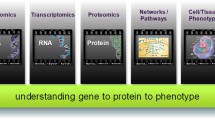Abstract
A fundamental goal of systems biology is to seek a better understanding of the cell’s molecular mechanisms. Experimentalists most frequently rely upon reductionist methods to isolate and analyze discrete signaling compartments, including subcellular domains, organelles, and protein–protein interactions. Among the systems-biology community, there is a growing need to integrate multiple datasets to resolve complex cellular networks. In this chapter, we share our procedures for the discovery of integrated signaling networks, across multi-proteomic data. Demonstrating these procedures, we provide an integrated analysis of the cellular proteome and extracellular (secretome) of human glioma LN229.
Access this chapter
Tax calculation will be finalised at checkout
Purchases are for personal use only
Similar content being viewed by others
References
Raudvere U, Kolberg L, Kuzmin I, Arak T, Adler P, Peterson H et al (2019) g:Profiler: a web server for functional enrichment analysis and conversions of gene lists (2019 update). Nucleic Acids Res 47(W1):W191–W1W8. https://doi.org/10.1093/nar/gkz369
Yan J, Risacher SL, Shen L, Saykin AJ (2018) Network approaches to systems biology analysis of complex disease: integrative methods for multi-omics data. Brief Bioinform 19(6):1370–1381. https://doi.org/10.1093/bib/bbx066
Hasin Y, Seldin M, Lusis A (2017) Multi-omics approaches to disease. Genome Biol 18(1):83. https://doi.org/10.1186/s13059-017-1215-1
Aftab Q, Mesnil M, Ojefua E, Poole A, Noordenbos J, Strale PO et al (2019) Cx43-associated secretome and interactome reveal synergistic mechanisms for glioma migration and MMP3 activation. Front Neurosci 13:143. https://doi.org/10.3389/fnins.2019.00143
Poole AT, Sitko CA, Le C, Naus CC, Hill BM, Bushnell EAC et al (2020) Examination of sulfonamide-based inhibitors of MMP3 using the conditioned media of invasive glioma cells. J Enzyme Inhib Med Chem 35(1):672–681. https://doi.org/10.1080/14756366.2020.1715387
Tyanova S, Temu T, Cox J (2016) The MaxQuant computational platform for mass spectrometry-based shotgun proteomics. Nat Protoc 11(12):2301–2319. https://doi.org/10.1038/nprot.2016.136
Martens M, Ammar A, Riutta A, Waagmeester A, Slenter DN, Hanspers K et al (2021) WikiPathways: connecting communities. Nucleic Acids Res 49(D1):D613–D621. https://doi.org/10.1093/nar/gkaa1024
Shannon P, Markiel A, Ozier O, Baliga NS, Wang JT, Ramage D et al (2003) Cytoscape: a software environment for integrated models of biomolecular interaction networks. Genome Res 13(11):2498–2504. https://doi.org/10.1101/gr.1239303
Acknowledgements
VC is supported by NSERC Discovery Grant and the Canadian Foundation for Innovation (CFI). The authors would like to acknowledge Christian C. Naus and Wun Chey Sin for provisions of LN229 glioma. The authors also thank Leonard J. Foster and Nikolay Stoynov for providing LC-MS/MS instrument time.
Author information
Authors and Affiliations
Corresponding author
Editor information
Editors and Affiliations
1 Electronic Supplementary Material
Data 1
Example data and files have been provided. Mass spectrometry proteomics data have been deposited to the ProteomeXchange Consortium via PRIDE (dataset identifier PXD024001 and https://doi.org/10.6019/PXD024001). MaxQuant output combine files have been included in the supplement information (Supplemental Material, available on link.springer.com) (XLSX 62 kb)
Data 2
LN229 Cellular Proteome. LN229 were grown in high glucose DMEM with 10% FBS in a controlled environment (5% CO2, 36.5 °C). Cells were expanded to 5–150 mm plates, passed every 3–4 days, and harvested at 80% confluency. Cell were rinsed with phosphate buffered saline (PBS), plates were scraped in the presence of 500 μL of digestion buffer (1% deoxycholate, ammonium bicarbonate, pH 8), heated (100 °C, 5 min) and incubated on ice. The sample was briefly homogenized by probe sonication. Following reduction and alkylation, proteins were digested with sequence-grade modified trypsin (Promega, 1:50, 36.5 °C, 16 h, overnight). Samples were acidified with trifluoroacetic acid (TFA) (2%) and centrifuged (12,000 RCF). Clarified supernatants were enriched using a commercial C18 solid phase extraction column (Isoelute). Peptides were dried and resuspended in 200 μL, pH 10, 20 mM ammonium formate. Peptides were fractionated by off-line HPLC (pH 10, 20 mM ammonium formate, Agilent 1100 HPLC, 50 μL/min) with a linear gradient, 10–40% acetonitrile/water (20 mM ammonium formate) over 60 min. Peptides were monitored by UV absorbance detection (218 nm). Separations were conducted with a custom packed column (100 x 1 mm, Waters XBridge C18, 5 μm); and eluates collected (1 min/fraction) with a Gilson 203B fraction collector. Samples (total of 30) were resuspended in HPLC-MS sample buffer (pH 2, 1% TFA, 1% acetic acid) in preparation for analysis. A total of 30 raw files are contained within this set (ZIP 3568 kb)
Data 3
LN229 Secretome: Condition media was collected from 4 x 150 mm plates with cells at 80% confluency. Cells were rinsed twice with PBS and replaced with 15 mL of serum-free Dulbecco’s Modified Eagle’s Medium (DMEM), and incubated (24 h). Conditioned media was collected, treated with protease inhibitor (complete Mini, Roche), and chilled (4 °C). This media was distributed across 5 conical tubes (50 mL) and diluted to 75% ethanol. Precipitated proteins were collected by centrifugation (8000 RCF, 15 min), decanted, and solubilized with digestion buffer (as above). Sample preparation steps were carried out as above, except for the omission of pH 10 off-line HPLC. Secretome data represents 4 HPLC-MS (biological replicate) runs (ZIP 2078 kb)
Data 4
Mass spectrometry and MaxQuant data analysis. Secretome and cellular proteome samples were analyzed using LTQ-ObitrapVelos (Thermofisher). Data dependent acquisition (DDA) parameters can be found within the instrumental Raw files. Datasets were searched with MaxQuant (v1.6.10.43). UniProt reference proteome (human, 9606, 15/05/2020). The complete set of parameters used for MaxQuant searches can be found in the parameters.txt file (combine -> txt -> parameters.txt) (XLSX 2194 kb)
Rights and permissions
Copyright information
© 2022 The Author(s), under exclusive license to Springer Science+Business Media, LLC, part of Springer Nature
About this protocol
Cite this protocol
Helwer, R., Chen, V.C. (2022). Integrated Network Discovery Using Multi-Proteomic Data. In: Geddes-McAlister, J. (eds) Proteomics in Systems Biology. Methods in Molecular Biology, vol 2456. Humana, New York, NY. https://doi.org/10.1007/978-1-0716-2124-0_12
Download citation
DOI: https://doi.org/10.1007/978-1-0716-2124-0_12
Published:
Publisher Name: Humana, New York, NY
Print ISBN: 978-1-0716-2123-3
Online ISBN: 978-1-0716-2124-0
eBook Packages: Springer Protocols




